Otoplasty in Orange County
Otoplasty refers to plastic surgery of the ears. “Oto” is from Greek origins and means “ear”; the suffix, “plasty” means “to shape or mold”. Ear deformities (e.g. protruding ears) can cause deeper emotional upset than is generally realized by the patient’s friends or parents. Because the visual and psychological improvement following the operation is usually dramatic, it is rewarding to the patient, the family, and to the surgeon.
What Can an Otoplasty Correct?
An otoplasty can correct:
- Misshapen ears
- Protruding ears (ears that stick out)
- Large ears
- Asymmetric ears
How is an Otoplasty Performed?
In younger children, a general anesthetic is given in a hospital surgery suite that caters to children. In adults, the procedure can be accomplished in Dr. Boeckmann's clinic procedure room under local anesthetic or under a general anesthetic at a surgical center.
Surgical incisions are located behind each ear and are hidden in the creases behind them. The type of procedure performed is highly customized and tailored to the individual needs of the patient. Most cases involve “pinning” the ears closer to the head and/ or reshaping deformed cartilage with sutures. In all cases, Dr. Boeckmann strives for natural appearing results.
What is the Recovery Following an Otoplasty?
In most cases there is minimal pain after this type of surgery. If severe pain is present, Dr. Boeckmann will want to examine you for potential rare complications.
A turban-type bandage is worn about the head to cover the ears the night after surgery. After this bandage is removed the next morning, the patient wears a stocking cap or headband pulled down over the ears while sleeping to protect them for another two weeks. When the dressings are first removed the ears will appear to have been over corrected or too close to the head, but in time they begin to assume their new position. The sutures used to close the skin incisions behind the ears usually dissolve on their own. Most patients may return to work or school in 5-7 days following surgery.
How Long will the Otoplasty Results Last?
Usually, the cartilages will retain the shape and position that they are sutured into permanently. However, when the ear cartilage is thick and strong, it tends to resist being repositioned and a slight touch-up might be indicated at 12 months.
Does Insurance Cover Otoplasty?
Most otoplasty procedures are considered cosmetic. Therefore, insurance companies do not generally cover the cost of surgery. However, we will be happy to assist with an inquiry to your insurance company, particularly in pediatric cases.


